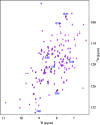Solution structure of an arsenate reductase-related protein, YffB, from Brucella melitensis, the etiological agent responsible for brucellosis
- PMID: 21904062
- PMCID: PMC3169414
- DOI: 10.1107/S1744309111006336
Solution structure of an arsenate reductase-related protein, YffB, from Brucella melitensis, the etiological agent responsible for brucellosis
Abstract
Brucella melitensis is the etiological agent responsible for brucellosis. Present in the B. melitensis genome is a 116-residue protein related to arsenate reductases (Bm-YffB; BR0369). Arsenate reductases (ArsC) convert arsenate ion (H(2)AsO(4)(-)), a compound that is toxic to bacteria, to arsenite ion (AsO(2)(-)), a product that may be efficiently exported out of the cell. Consequently, Bm-YffB is a potential drug target because if arsenate reduction is the protein's major biological function then disabling the cell's ability to reduce arsenate would make these cells more sensitive to the deleterious effects of arsenate. Size-exclusion chromatography and NMR spectroscopy indicate that Bm-YffB is a monomer in solution. The solution structure of Bm-YffB (PDB entry 2kok) shows that the protein consists of two domains: a four-stranded mixed β-sheet flanked by two α-helices on one side and an α-helical bundle. The α/β domain is characteristic of the fold of thioredoxin-like proteins and the overall structure is generally similar to those of known arsenate reductases despite the marginal sequence similarity. Chemical shift perturbation studies with (15)N-labeled Bm-YffB show that the protein binds reduced glutathione at a site adjacent to a region similar to the HX(3)CX(3)R catalytic sequence motif that is important for arsenic detoxification activity in the classical arsenate-reductase family of proteins. The latter observation supports the hypothesis that the ArsC-YffB family of proteins may function as glutathione-dependent thiol reductases. However, comparison of the structure of Bm-YffB with the structures of proteins from the classical ArsC family suggest that the mechanism and possibly the function of Bm-YffB and other related proteins (ArsC-YffB) may differ from those of the ArsC family of proteins.
Figures









Similar articles
-
Crystal structure of the YffB protein from Pseudomonas aeruginosa suggests a glutathione-dependent thiol reductase function.BMC Struct Biol. 2004 Mar 8;4:5. doi: 10.1186/1472-6807-4-5. BMC Struct Biol. 2004. PMID: 15102337 Free PMC article.
-
A Hybrid Mechanism for the Synechocystis Arsenate Reductase Revealed by Structural Snapshots during Arsenate Reduction.J Biol Chem. 2015 Sep 4;290(36):22262-73. doi: 10.1074/jbc.M115.659896. Epub 2015 Jul 29. J Biol Chem. 2015. PMID: 26224634 Free PMC article.
-
Validation of arsenic resistance in Bacillus cereus strain AG27 by comparative protein modeling of arsC gene product.Protein J. 2011 Feb;30(2):91-101. doi: 10.1007/s10930-011-9305-5. Protein J. 2011. PMID: 21258851
-
Insights into the structure, solvation, and mechanism of ArsC arsenate reductase, a novel arsenic detoxification enzyme.Structure. 2001 Nov;9(11):1071-81. doi: 10.1016/s0969-2126(01)00672-4. Structure. 2001. PMID: 11709171
-
Arsenate reduction: thiol cascade chemistry with convergent evolution.J Mol Biol. 2006 Sep 8;362(1):1-17. doi: 10.1016/j.jmb.2006.07.002. Epub 2006 Aug 14. J Mol Biol. 2006. PMID: 16905151 Review.
Cited by
-
Novel arsenic-transforming bacteria and the diversity of their arsenic-related genes and enzymes arising from arsenic-polluted freshwater sediment.Sci Rep. 2017 Sep 11;7(1):11231. doi: 10.1038/s41598-017-11548-8. Sci Rep. 2017. PMID: 28894204 Free PMC article.
-
Crystal structure of a hemerythrin-like protein from Mycobacterium kansasii and homology model of the orthologous Rv2633c protein of M. tuberculosis.Biochem J. 2020 Jan 31;477(2):567-581. doi: 10.1042/BCJ20190827. Biochem J. 2020. PMID: 31913442 Free PMC article.
-
Structural diversity in the Mycobacteria DUF3349 superfamily.Protein Sci. 2020 Mar;29(3):670-685. doi: 10.1002/pro.3758. Epub 2019 Nov 21. Protein Sci. 2020. PMID: 31658388 Free PMC article.
-
A reduction-secretion system contributes to roxarsone (V) degradation and efflux in Brevundimonas sp. M20.BMC Microbiol. 2025 Jan 14;25(1):23. doi: 10.1186/s12866-024-03740-4. BMC Microbiol. 2025. PMID: 39810137 Free PMC article.
References
Publication types
MeSH terms
Substances
Associated data
- Actions
Grants and funding
LinkOut - more resources
Full Text Sources

